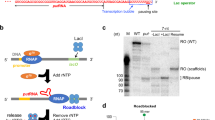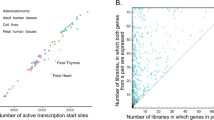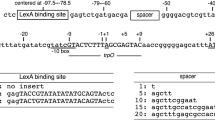Abstract
The nucleotide sequences of the intercistronic regions from several multicistronic operons have recently been determined. In many cases such intercistronic regions consist of only a few base pairs (bp); in certain extreme cases, where the initiation codon of one gene overlaps the termination codon of the previous gene, intercistronic regions are essentially absent1,2. However, in other cases intercistronic regions can be up to several hundred base pairs long; it seems reasonable to suppose that, at least in these cases, such regions have a role in regulating expression of the operon. Indeed, a regulatory function for the large intercistronic region of the rplJL–rpoBC operon has been demonstrated3. We have now identified a genetic element, common to intercistronic regions from three independent bacterial operons (the histidine transport and the histidine biosynthetic operons of Salmonella typhimurium and the malK–lamB operon of the malB region of Escherichia coli), which we believe to be important in regulating the differential expression of individual genes in these multicistronic operons. A similar element is also found immediately following the trpR gene of E. coli although in this case it is not known whether or not a distal gene exists. Each of these elements consists of a long dyad symmetry which, once transcribed, could form an exceptionally stable stem–loop structure with a stem of up to 35 bp. In each case smaller palindromic units are also found, some of which overlap the main symmetry. The stem–loop structures show remarkable homology (---90%) and probably have a common evolutionary origin, possibly an insertion element. It seems that the function of these structures is to effect a decrease in expression of distal genes in an operon.
This is a preview of subscription content, access via your institution
Access options
Subscribe to this journal
Receive 51 print issues and online access
$199.00 per year
only $3.90 per issue
Buy this article
- Purchase on Springer Link
- Instant access to full article PDF
Prices may be subject to local taxes which are calculated during checkout
Similar content being viewed by others
References
Christie, G. E. & Platt, T. J. molec. Biol. 142, 519–530 (1980).
Selker, E. & Yanofsky, C. J. molec. Biol. 130, 135–143 (1979).
Barry, G., Squires, C. & Squires, C. L. Proc. natn. Acad. Sci. U.S.A. 77, 3331–3335 (1980).
Higgins, C. F. et al. Nature 298, 723–727 (1982).
Borer, P. N., Dengler, B. & Tinoco, I. J. molec. Biol. 86, 845–853 (1974).
Clement, J. M. & Hofnung, M. Cell 27, 507–514 (1981).
Gunsalus, R. P. & Yanofsky, C. Proc. natn. Acad. Sci. U.S.A. 77, 7117–7121 (1980).
Singleton, C. K., Roeder, W. D., Bogosian, G., Somerville, R. L. & Weith, H. L. Nucleic Acids Res. 8, 1551–1560 (1980).
Whitfield, H. J. et al. J. molec. Biol. 49, 245–249 (1970).
Gegenheimer, P., Watson, N. & Apirion, D. J. biol. Chem. 252, 3064–3073 (1977).
Robertson, H. D., Dickson, E. & Dunn, J. J. Proc. natn. Acad. Sci. U.S.A. 74, 822–826 (1977).
Bram, R. J., Young, R. A. & Steitz, J. A. Cell 19, 393–401 (1980).
Calos, M. P. & Miller, J. H. Cell 20, 579–595 (1980).
Andersen, R. P. & Roth, J. R. J. molec. Biol. 119, 147–166 (1978).
Ardeshir, F., Higgins, C. F. & Ames, G. F.-L. J. Bact. 147, 401–409 (1981).
Author information
Authors and Affiliations
Rights and permissions
About this article
Cite this article
Higgins, C., Ames, GL., Barnes, W. et al. A novel intercistronic regulatory element of prokaryotic operons. Nature 298, 760–762 (1982). https://doi.org/10.1038/298760a0
Received:
Accepted:
Issue Date:
DOI: https://doi.org/10.1038/298760a0
This article is cited by
-
Plastid genome data provide new insights into the dynamic evolution of the tribe Ampelopsideae (Vitaceae)
BMC Genomics (2024)
-
Non-serogroup O1/O139 agglutinable Vibrio cholerae: a phylogenetically and genealogically neglected yet emerging potential pathogen of clinical relevance
Archives of Microbiology (2022)
-
Isolation and characterization of Pseudomonas syringae pv. syringae which induce leaf spot on walnut
European Journal of Plant Pathology (2016)
-
Molecular characterization of Diplodia seriata, a new pathogen of Prunus laurocerasus in Italy
Phytoparasitica (2014)
-
Evolution of REP diversity: a comparative study
BMC Genomics (2013)
Comments
By submitting a comment you agree to abide by our Terms and Community Guidelines. If you find something abusive or that does not comply with our terms or guidelines please flag it as inappropriate.



